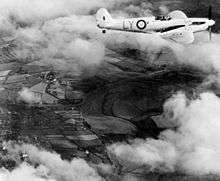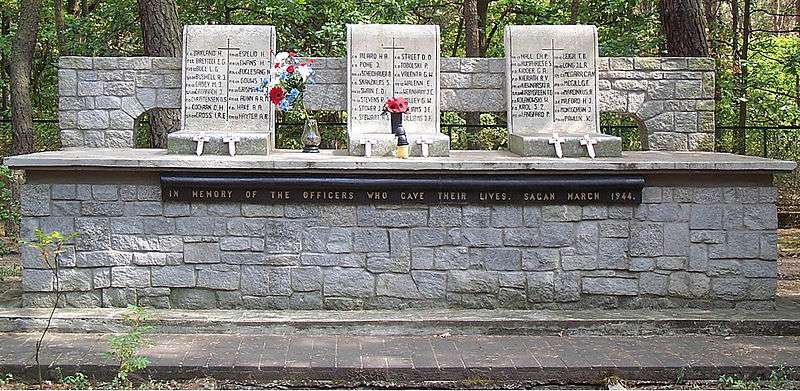Sandy Gunn
| Alastair Donald Mackintosh Gunn | |
|---|---|
 | |
| Birth name | Alastair Donald Mackintosh Gunn |
| Nickname(s) | Sandy |
| Born |
27 September 1919 Auchterarder, Perthshire, Scotland |
| Died |
6 April 1944 (aged 24) between Gorlitz and Breslau |
| Buried at | Poznan Old Garrison Cemetery, Poland |
| Allegiance |
|
| Service/branch |
|
| Years of service | 1940–1944 |
| Rank | Flight Lieutenant |
| Service number | 60340 |
| Unit | No. 1 Photographic Reconnaissance Unit RAF |
| Battles/wars | |
| Awards |
Mentioned in Despatches Twice |
Alastair Donald Mackintosh "Sandy" Gunn (27 September 1919 – 6 April 1944), was a British Supermarine Spitfire photo reconnaissance pilot who was taken prisoner during the Second World War. Gunn took part in the "Great Escape" from Stalag Luft III in March 1944, and was one of the men re-captured and subsequently executed by the Gestapo.
Pre-war life
Gunn was born at home in Auchterarder,[1] Perthshire, the son of surgeon James Turner Gunn, MB, ChB, FRCS and Adelaide Lucy Frances [nee Macdonald] Gunn.[2] He was reportedly a fine athlete at school. After leaving school, Gunn became an engineering apprentice at the Govan, Glasgow shipyard of Harland and Wolff. After a year he gained entry to Pembroke College to study mechanical sciences hoping for a career as a diesel engineer.[3]
Early war service

Gunn enlisted in the Royal Air Force on 22 February 1940 and commenced active service on 22 June 1940 as an aircrew candidate (airman 2nd class). On 18 January 1941 he received his pilot's brevet and promotion to sergeant. He was commissioned as a Pilot Officer on 25 January 1941.[4] Gunn subsequently joined No. 48 Squadron RAF of RAF Coastal Command flying Avro Anson aircraft on photo reconnaissance missions.[5] A reliable record flying with the squadron led to Gunn being posted to RAF Benson to fly stripped-down high-altitude conversion Supermarine Spitfires with the RAF in September 1941. Gunn was promoted to Flying Officer on 25 January 1942,[6] and flew many long-range missions over German naval units on the Norwegian coast and in the North Atlantic, often in terrible weather conditions. On one occasion he crashed in the North Atlantic after his aircraft ran out of fuel.[7]
Prisoner of war
At 0807 hours on the morning of 5 March 1942,[8] Gunn took off from RAF Wick in Supermarine Spitfire[9][10] on a photo reconnaissance mission of the German naval anchorages on the Norwegian coastline near Trondheim, Norway. He was shot down by two Messerschmitt Bf 109s from Jagdgruppe Losigkeit, flown by Leutnants Heinz Knoke and Dieter Gerhard.[11][12][13] Gunn bailed out before his Spitfire crashed near Langurda, Surnadal, Norway, and was made a prisoner of war.[14][15]
Gunn was initially suspected by the Germans of having flown from a covert RAF base in somewhere in northern Norway. He was questioned over a period of three weeks before being processed into the prison camp system.[16] Gunn was sent to Stalag Luft III in the German province of Lower Silesia near the town of Sagan (now Żagań, Poland), where he became a regular member of the tunneling team.[17][18] In captivity, Gunn was promoted to Flight Lieutenant (24 January 1943).[19]
The 'Great Escape'

| Nationalities of the 50 executed |
Gunn was one of 76 men who escaped the prison camp on the night of 24–25 March 1944 in the now famous "Great Escape". The alarms sounded upon the discovery of the escape attempt when he had been outside the wire for less than an hour. Gunn was quickly arrested on the road to Gorlitz (to the south of the camp),[20] and arrived at the collection point for recaptured officers at Gorlitz prison.[21][22][23]
The prisoners were interrogated harshly. Mike Casey and Gunn were both told that they would lose their heads.[24][25] At Gorlitz Prison on the morning of 6 April 1944, Tony Bethell heard a truck arrive and saw three Germans in uniform call out the names of Denys Street, Neville McGarr, Jack Grisman, Sandy Gunn, Harold Milford, and John F Williams.[26][27][28][29]
Outcome
Gunn was one of 50 escapees executed by the Gestapo.[30][31][32] He was cremated at Breslau.[33][34] Originally his remains were buried at Sagan, although his ashes are now interred in the Old Garrison Cemetery, Poznan.[35]
Gunn's name was amongst those in the list of the murdered prisoners which was published in the press in the UK and Commonwealth countries when news broke on or about 20 May 1944.[36]
Post-war investigations saw a number of those guilty of the murders tracked down, arrested and tried for their crimes.
Awards
- Mentioned in Despatches on 5 June 1942 for service as pilot officer[37]
- Mentioned in Despatches for conspicuous gallantry as a prisoner of war.[38]
References
- Notes
- ↑ Andrews (1976), p.206
- ↑ Google search: Sandy Gunn; Vance; page online;
- ↑ Vance (2012), p.50
- ↑ The London Gazette: (Supplement) no. 35083. pp. 1081–1082. 21 February 1941. Retrieved 6 September 2015.
- ↑ Vance (2000), p.50
- ↑ The London Gazette: no. 35467. pp. 910–911. 24 February 1942. Retrieved 6 September 2015.
- ↑ Vance (2000), p.51
- ↑ Andrews (1976), p.206
- ↑ untitled; warhistoryonline website; includes details of aircraft AA810 and pilot.
- ↑ -Spitfire AA810; Asisbiz website
- ↑ untitled; ww2aircraft website; action in which Gunn was shot down described
- ↑ Loss of Spitfire AA810
- ↑ Vance (2000), p.51
- ↑ Last mission of Sandy Gunn (with photos); tihilde website
- ↑ Franck Ruffino - Spitfire AA810
- ↑ Vance (2000), p.51
- ↑ Andrews (1976) p.36
- ↑ Vance (2000), p.186
- ↑ The London Gazette: (Supplement) no. 36015. pp. 2158–2159. 11 May 1943. Retrieved 6 September 2015.
- ↑ Andrews (1976), p.50 and 206
- ↑ Vance (2000), p.244
- ↑ Read (2012), p.224
- ↑ Andrews (1976), p.49
- ↑ Vance (2000), p.253
- ↑ Andres (1976), p.49
- ↑ Vance (2000), p.267
- ↑ Note: No firm evidence was ever found of the fate of these six men; their records were marked "killed at a place unknown, on or after 6 April 1944"; Andrews (1976), p.50 and 187-189
- ↑ Read (2012), p.304
- ↑ "Stalag Luft III: The Fifty". Pegasus Archive. Retrieved 28 August 2015.
- ↑ List of Officers Murdered; SAAF Museum;
- ↑ Andrews (1976), p.206
- ↑ List; RCAF Website
- ↑ Read (2012), p.304
- ↑ Andrews (1976), p.317
- ↑ Alastair Donald Mackintosh Gunn; Commonwealth War Graves Commission
- ↑ Western Morning News, Dundee Courier, Yorkshire Post, etc. 20/05/1944
- ↑ The London Gazette: no. 35586. pp. 2522–2523. 5 June 1942.
- ↑ The London Gazette: (Supplement) no. 36544. pp. 2619–2620. 2 June 1944.
- Bibliography
- Ted Barris (2014). The Great Escape. Dundurn Publishing. ISBN 1459728440.
- Tim Carroll (2005). The Great Escape from Stalag Luft III. Pocket Publishing. ISBN 1416505318.
- Simon Read (2012). Human Game. Constable. ISBN 978-1-4721-1262-0.
- Sean Feast (2015). The Last of the 39-ers. Grub Street. ISBN 978-1909166158.
- Jonathan F Vance (2000). A Gallant Company. Pacifica Military. ISBN 978-0-935-55347-5.
- William Ash; Brendan Foley (2005). Under the Wire: The Wartime Memoir of a Spitfire Pilot, Legendary Escape Artist and 'Cooler King'. Bantam. ISBN 978-0-593-05408-6.
- Paul Brickhill (2004). The Great Escape. W.W. Norton & Company. ISBN 978-0-393-32579-9.
- Alan Burgess (1990). The Longest Tunnel: The True Story of World War II's Great Escape. Naval Institute Press. ISBN 978-1-59114-097-9.
- Albert P. Clark (2005). 33 Months as a POW in Stalag Luft III: A World War II Airman Tells His Story. Fulcrum Pub. ISBN 978-1-55591-536-0.
- Arthur A. Durand (1 January 1989). Stalag Luft III: The Secret Story. Patrick Stephens Limited. ISBN 978-1-85260-248-2.
- Allen Andrews. Exemplary Justice. Harrap. ISBN 0-245-52775-3.
- Vance, Jonathan F (2000). A Gallant Company: The Men of the Great Escape. Pacifica Military History; (Mar 2001). p. 41. ISBN 978-0-935-55347-5.
External links
- Lessons from History site analyses their efforts using modern project management methods, as the prisoners formally structured their work as a project.
Further reading
- Project Lessons from the Great Escape (Stalag Luft III), by Mark Kozak-Holland.